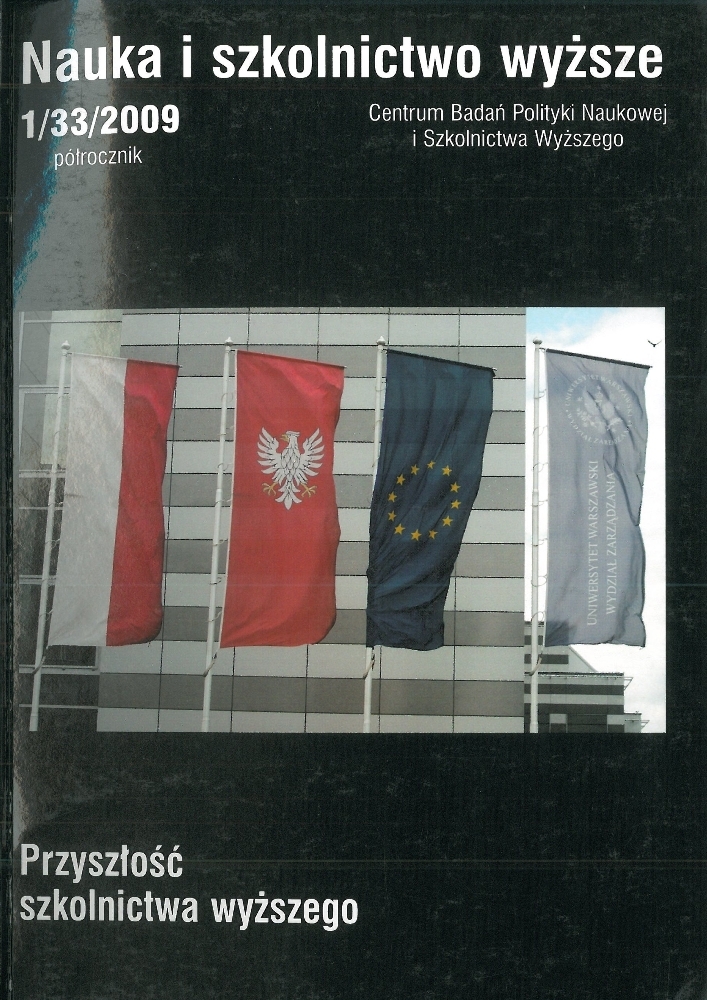Abstract
Spatial decentralisation of tertiary education was among the most important processes contributing to the spread of tertiary education in Western Europę in the second half of the 20th century. The idea to establish new universities in areas deprived of tertiary education was seen as a democratisation tool for this level of education and for countries’ regional policies. It was hoped that the arrival of new universities in peripheral regions would improve access to tertiary education both in spatial and in social terms and will stimulate social development and economic growth. The case which has received most coverage in literaturę is the one of spatial decentralisation of tertiary education in Sweden, which began in 1970s. After more than 30 years sińce start of the Swedish tertiary education reform the actual outcomes of the changes can be assessed and this issue is addressed in the paper.References
Aamodt PO. 1995 Floods, Bottlenecks and Backwaters: An Analysis ofExpansion in Higher Education in Norway, „Higher Education”, nr 1/30.
Altbach PG. 1999 The Logic of Mass Higher Education, „Tertiary Education and Management”, nr 2/5.
Andersson R. 2005 The Efficiency ofSwedish Regional Policy, „Annals of Regional Sciences”, nr 4/39
Andersson R., Ouigley J.M, Wilhelmson M. 2004 University Decentralization as Regional Policy: The Swedish Experiment, „Journal of Economic Geography” , nr 4/4.
Andersson R., Ouigley J.M., Wilhelmson M. 2005 Higher Education, Localization and lnnovation: Evidence from a Natura! Experiment, „Working Paper Series in Economics and Institutions of lnnovation from Royal Institute of Technology”,
nr 26.
Askling B, Almen E. 1997 From Participation to Competition: Changes in the Notion of Decentralization in Swedish Higher Educational Policy, „Tertiary Education and Management”, nr 3/3.
Benner M., Sórlin S. 2007 Shaping Strategie Research: Power, Resources, and Interests in Swedish Research Policy, „Minerva”, nr 1/44.
Blumberg M.J. 1986 The Democratization of Higher Education in Denmark, Finland, leeland, Norway and Sweden: A Cross-National Study of Post-War Reforms, Paper presented atthe Midwest Meeting of the International and Comparative Education Society (Chicago, IL, October 17-18, 1986).
Boucher G, Convay C., Van der Meer E. 2003 Tiers of Engagement by Universities in Their Region's Development, „Regional Studies”, nr 9/37.
Brockliss L. 2000 Gown and Town: The University and the City in Europę, 1200-2000, „Minerva”, nr 2/38.
Daun H., Hansson H. 2006 Towards Comparative Equality but Persisting lnequality in Relation to the Ambitions of Swedish Education, w: A. Odouran i H.S. Bhola (red.): Widening Access to Education as Social Justice, Springer, Amsterdam.
DrylerH. 1998 Educational Choice in Sweden: Studies on the Importance of Gender and Social Contexts, Ph.D. Thesis no. 31, Swedish Institute for Social Research, Stockholm University.
Eliasson K. 2006 The Effects of Accessibility to University Education on Enrollment Decisions, Geographical Mobility, and Social Recruitment, „Umea Economic Studies” , nr 690.
Eliasson K., Lindgren U., Westerlund O. 2003 Geographical Labour Mobility: Migration or Commuting?, „Regional Studies” , nr 8/37.
Hall R 1997 The University and the City, „GeoJournal” , nr 4/41.
Holzer S. 2006 The Expansion of Higher Education in Sweden and the Issue of Equality of Opportunity, Licenciate Thesis, Vaxjó University Press, Vaxjó.
Kalpazidou Schmidt E. 2007 Higher Education in Scandinavia, w: J.J.F. Forrest, RG. Altbach (red.): International Handbook of Higher Education, Springer, Amsterdam.
Kjellstróm C , Regner H. 1999 The Effects of Geographical Distance on the Decision to Enrol in University Education, „Scandinavian Journal of Educational Research” , nr 4/43.
Kyvik S. 1983 Decentralisation of Higher Education and Research in Norway, „Comparative Education”, nr 1/19.
Lundholm E. 2007 Are Movers Still the Same? Characteristics of Interregional Migrants in Sweden 1970-2001, „Tijdschrift voor Economische en Sociale Geografie”, nr 3/98.
Makieta Z., Kubejko-Polańska E., Karapyta M. 2008 Wyższa uczelnia w strukturze miasta (przykład Jarosławia), w: T. Markowski, D. Drzazga (red.): Rola wyższych uczelni w rozwoju społeczno-gospodarczym i przestrzennym miast, Studia Komitetu Przestrzennego Zagospodarowania Kraju PAN, nr 121.
Premfors R. 1984 Analysis in Politics: The Regionalization of Swedish Higher Education, „Comparative Education”, nr 1/28.
Saarivirta T., Consoli D. 2007 Where Did They Go? A Study on Newly Established Universities and Graduate Mobility in Finland, „SANTE Working Papers”, nr 13/2007.
Szulc T. 2004 Dynamika przemian w szkolnictwie wyższym w Polsce a realizacja procesu bolońskiego, „Nauka i Szkolnictwo Wyższe”, nr 2/24.
Świerzbowska-Kowalik E. 2000 Wykształcenie środowisk rodzinnych i miejsce zamieszkania jako wyznaczniki szans na podjęcie studiów, „Nauka i Szkolnictwo Wyższe”, nr 2/16.
